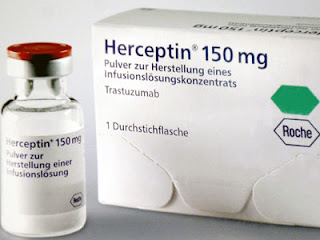 October has been hopping with news and research about the aromatase inhibitor Femara (letrozole) for breast cancer. Today we'll share the five latest studies and the headlines about them. Links may be found on the Femara (letrozole) page of our website.
October has been hopping with news and research about the aromatase inhibitor Femara (letrozole) for breast cancer. Today we'll share the five latest studies and the headlines about them. Links may be found on the Femara (letrozole) page of our website.Femara more effective than tamoxifen
The big story this month was an October 21 study in The Lancet Oncology which compared 8 year recurrence and survival rates for postmenopausal women taking Femara, tamoxifen or a sequential combination of both for early-stage, hormone-receptor positive breast cancer. The study is known as the Breast International Group (BIG) 1-98 study. The New York Times, The Telegraph (UK), US News and World Report/HealthDay and Medical News Today all ran stories.
According to the study, Femara alone resulted in a reduction in breast cancer recurrence and death compared to tamoxifen alone. Sequential use of tamoxifen and Femara, in any order, did not improve outcome compared to Femara alone, "but might be useful strategies when considering an individual patient's risk of recurrence and treatment tolerability."
Femara improves response to chemotherapy before surgery
Not all of the October Femara studies made headlines. An October 16 study in Breast Cancer Research and Treatment evaluated the addition of Femara to chemotherapy before surgery for postmenopausal women with locally advanced breast cancer. For women with hormone-receptor positive breast cancer, the addition of Femara to chemotherapy improved clinical and pathological response rates with "acceptable toxicity" compared to chemotherapy alone.
Femara reduces bone mineral density
Not all Femara news this month was good. An October 14 Annals of Oncology study evaluated bone loss in women in the BIG 1-98 study discussed above. It found that Femara use was associated with a reduction in bone mineral density, whether used alone or in sequence with tamoxifen, when compared to the use of tamoxifen alone. In fact, the "sequential schedules were as detrimental for bone density" as taking Femara alone.
Zometa improves bone mineral density for women taking Femara
There may be a way to reduce the risk of bone loss associated with Femara. An October 10 study in the journal Cancer compared the immediate use of Zometa (zoledronic acid) with the delayed use in postmenopausal women with early breast cancer taking Femara for 5 years. The trial is known as Z-FAST. The Los Angeles Times and Medical News Today covered the study.
According to the study, taking Zometa (zoledronic acid) with Femara "upfront," from the beginning, "significantly and progressively" increases bone mineral density, compared with a delayed start of Zometa. The authors also found that "long-term coadministration of letrozole and zoledronic acid is well tolerated."
Another study evaluated the data from the Z-FAST trial. Whereas the October 10 Cancer study looked at bone mineral density at 5 years, an October 17 study in Clinical Breast Cancer evaluated the data at month 12. It also found that immediate use of Zometa prevented bone loss and increased bone mineral density, "regardless of BMD [bone mineral density] at baseline."
These are only the five most recent studies on Femara (letrozole) for breast cancer. For two years of news and research, plus overviews and FDA information, please check the Femara (letrozole) page of our LATESTBreastCancer.com website. From the home page, click the Treatments tab and search for 'Femara' in the search box on the top right of the page.
We'll continue to follow developments in breast cancer research. Links are added to our website daily and interesting findings are highlighted here. Please stay tuned.


